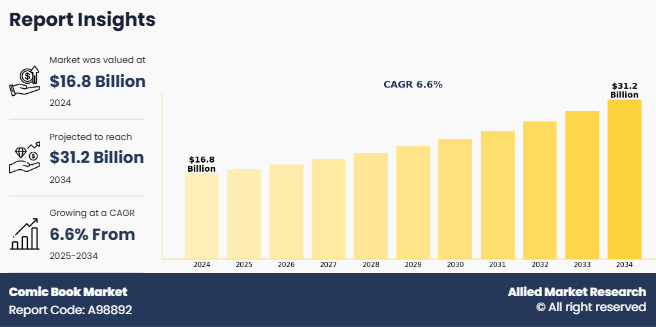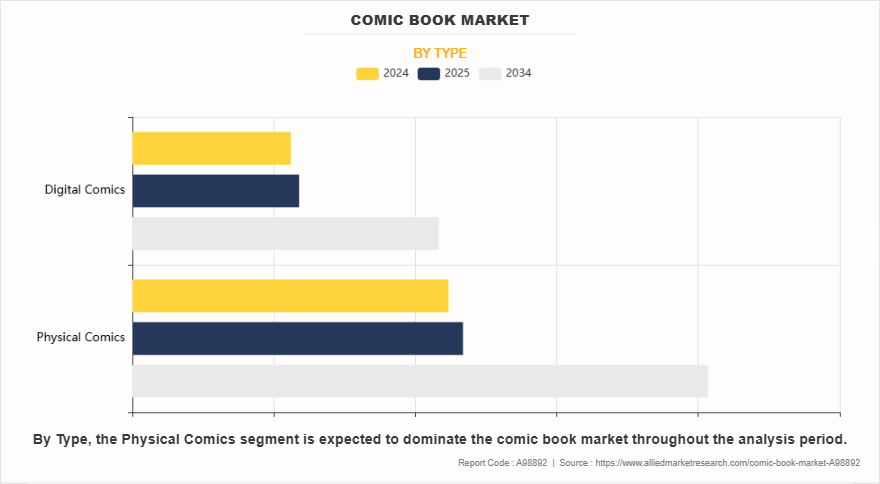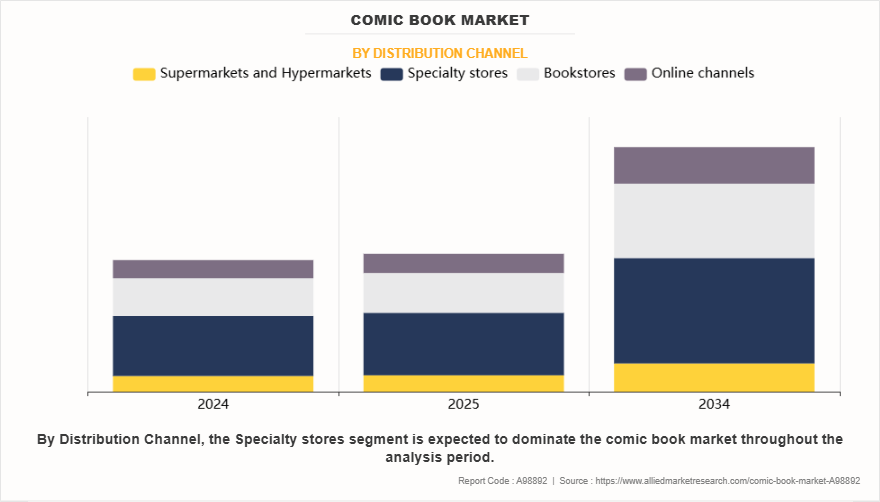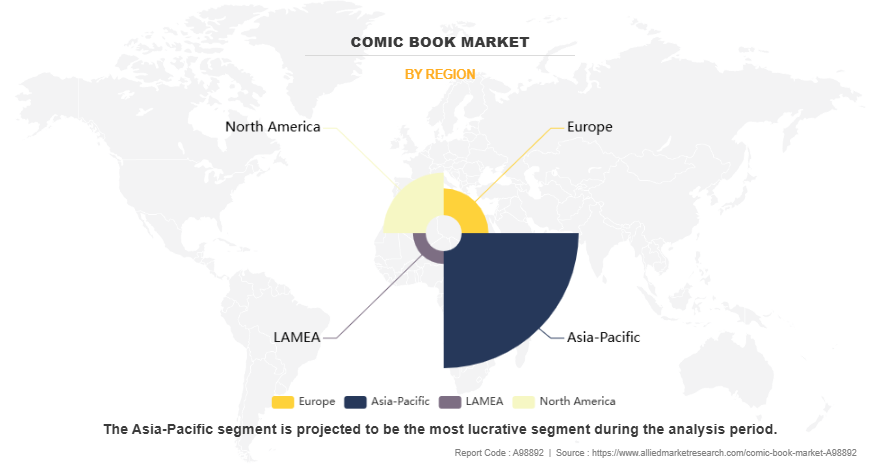Comic Book Market Research, 2034
The global comic book market was valued at $16.8 billion in 2024, and is projected to reach $31.2 billion by 2034, growing at a CAGR of 6.6% from 2025 to 2034. A comic book is a publication that uses illustrated panels and dialogue to narrate a story, combining visual art with text. It includes formats such as superhero stories, fantasy, science fiction, romance, and graphic novels. Comic books are popular for their visual storytelling, immersive plots, and connection to film, television, and gaming franchises. Teenagers and young adults have shown strong interest, along with collectors and digital readers. Demand remains high for superhero comics, manga, and webtoons across global markets, supported by accessible platforms and a growing culture of fandom and merchandise.

Market Dynamics
The expansion of superhero franchises in film and TV has boosted global demand for comic books by driving attention toward original storylines and characters. Major studio productions such as those from Marvel Studios and Warner Bros. attract large audiences who seek out comic books to explore character development, alternate timelines, and historical plotlines. Interest in comic book source material rises following the release of films and television series, which leads to higher sales of both vintage issues and newly released comic book titles. Comic books that feature screen-adapted characters experience renewed visibility among consumers who are newly introduced to superhero narratives, thus driving the comic book market growth.
Moreover, merchandise tie-ins, global marketing campaigns, and streaming availability of superhero content contribute to continued reader engagement, which in turn has driven market expansion in recent years. Comic book publishers respond to film and TV success by releasing reprints, special editions, and limited series that align with characters featured in screen adaptations. In addition, consistent release schedules for cinematic universes maintain demand for comics and generate ongoing demand for print and digital comic content. Thus, comic book publishers benefit from collaboration with film and TV franchises by attracting new readers, encouraging collectors, and expanding the audience reach across different regions and drive comic book market size.
However, high dependency on a few major publishers such as Marvel, DC, and Image Comics limits content diversity and restricts the expansion of the comic book market. Major publishers control a significant share of print and distribution operations, which concentrates availability around a fixed range of character-driven franchises. Comic book retailers prioritize shelf space and promotional focus on titles from dominant publishers, which reduces opportunities for smaller or independent releases. Repetitive narratives, constant reboots, and extensive crossover events within large franchises contribute to reader fatigue and reduce interest among audiences seeking original content.
In addition, limited market access for independent creators and smaller publishers lowers the variety of stories and artistic styles available to readers, which has resulted in slower market growth. Potential buyers may lose interest in comic book content when faced with series that require deep familiarity with existing universes or extended continuity. Consequently, small publishers face significant barriers in scaling distribution and attracting new readers owing to limited exposure in physical and online retail environments. Also, overdependence on a few major players creates market risk during periods of creative slowdown or internal restructuring. Lack of publisher diversity is anticipated to hamper the demand for comic books by limiting creative variety and reducing access to alternative content.
Furthermore, collaborations with gaming and metaverse platforms are creating opportunities in the comic book market by introducing comic book characters and storylines to interactive digital spaces. Integration of comic book intellectual properties into games allows publishers to reach gaming audiences and generate interest in source material. Titles such as Fortnite, Injustice, and Marvel’s Spider-Man feature narratives rooted in comic books, encouraging players to explore original issues. Virtual merchandise, in-game collectibles, and character skins based on comic book franchises further promote brand recognition and deepen engagement.
Also, metaverse environments provide immersive formats for storytelling through virtual comic book launches, digital galleries, and interactive fan experiences. Publishers benefit from extended visibility and new revenue streams by offering non-fungible tokens (NFTs), augmented reality comics, and avatar-based content tied to comic book worlds. Digital crossover events and co-branded promotions expand audience touchpoints and increase demand for related comic book titles. Independent creators also find new exposure through partnerships with virtual platforms that highlight unique visual styles and niche genres. Increased time spent on digital platforms, along with rising interest in hybrid entertainment formats, is expected to support the development of content strategies that link comic book publishing with gaming and virtual settings.
Segmental Overview
The comic book market is segmented into type, distribution channel, and region. Based on type, the market is divided into physical comics and digital comics. The digital comic segment is further bifurcated into traditional and webcomics. Based on distribution channel, the market is categorized into supermarkets and hypermarkets, specialty stores, bookstores, and online channels. Region-wise, it is analyzed across North America (U.S., Canada, and Mexico), Europe (UK, Germany, France, Italy, Spain, Netherlands, and rest of Europe), Asia-Pacific (China, Japan, India, South Korea, Australia, and rest of Asia-Pacific), and LAMEA (Brazil, Argentina, Saudi Arabia, UAE, South Africa, and rest of LAMEA).
By Type

By type, the physical comics segment dominated the global comic book market share in 2024 and is anticipated to maintain its dominance during the forecast period. Print editions continue to attract collectors and long-time readers who value tangible formats, including single issues, graphic novels, and limited runs. Publishers frequently release variant covers, special editions, and anniversary reprints that strengthen interest in physical formats. Independent bookstores, comic shops, and major retailers actively support physical distribution, offering in-store experiences, recommendations, and events tied to new releases. The presence of exclusive merchandise and signings further increases foot traffic and boosts retail sales of physical comics.
Moreover, preference for print formats is also supported by consumer sentiment tied to ownership and collection. Many readers view physical comics as lasting items with personal or monetary value. Offline purchases also appeal to readers who follow ongoing series and want to maintain consistent collections. Retail promotions and dedicated shelf space for new and classic titles support continued visibility in major markets. In addition, conventions and free comic book campaigns consistently feature physical giveaways and early access editions, strengthening demand for printed formats.
By Distribution Channel

By distribution channel, the specialty stores segment dominated the global comic book market in 2024 and is anticipated to maintain its dominance during the forecast period. Specialty comic stores serve as dedicated retail centers where readers access newly released issues, back issues, collectibles, and exclusive editions. Staff knowledge, carefully selected inventory, and community engagement contribute to a personalized buying experience that supports frequent visits and strong customer loyalty. Many specialty stores organize weekly release schedules, in-store signings, and artist appearances, which increases consumer interest in regular purchases and pre-orders of upcoming titles.
Also, specialty stores play a key role in supporting independent publishers and creator-owned content, as they offer shelf space that may not be available in larger retail chains. Print-focused readers prefer shopping at specialty stores owing to the availability of rare issues, direct publisher tie-ins, and genre-specific recommendations. Moreover, store-exclusive cover variants and locally hosted events attract collectors and dedicated readers who seek unique content. The specialized nature of comic book retailing, along with direct engagement strategies, is anticipated to position specialty stores as a major channel for comic book sales worldwide.
By Region

Region-wise, Asia-Pacific is anticipated to dominate the market with the largest share during the comic book market forecast period. Strong readership in countries such as Japan, South Korea, and China is expected to drive sales, particularly through manga and webtoon formats. High digital adoption has expanded reach among younger consumers, supported by mobile apps, online platforms, and serialized content delivery. Publishers in the region consistently produce high-volume content with a variety of genres, which attracts a wide and engaged reader base that supports both print and digital formats.
Furthermore, local demand is strengthened by strong domestic publishing infrastructure and integration of comic content into mainstream entertainment. Successful anime adaptations of popular manga titles drive interest in original print versions. Print volumes continue to maintain relevance owing to collector habits and serialized publishing formats, especially in Japan. Simultaneously, digital platforms such as LINE Webtoon and Kakao Page further increase readership, offering easy access to a vast library of titles. Continuous innovation in content format, along with merchandising and cross-media expansion is anticipated to boost the comic book market in Asia-Pacific region.
Competitive Analysis
The key players operating in the global comic book industry include ACK Media Direct Limited, Archie Comic Publications, Inc., Daewon Media Co., Ltd., Embracer Group AB, Kodansha Ltd., Shogakukan Co., Ltd., Square Enix Holdings Co., Ltd, The Walt Disney Company, Titan Publishing Group Ltd., and Warner Bros. Discovery, Inc. Several well-known and upcoming brands are vying for market dominance in the expanding comic book market in the region. Smaller niche firms are more well-known for catering to consumer demands and preferences in the global market. Large conglomerates, however, control most of the market and often buy innovative start-ups to broaden their product lines.
Key Benefits For Stakeholders
- This report provides a quantitative analysis of the market segments, current trends, estimations, and dynamics of the comic book market analysis from 2024 to 2034 to identify the prevailing comic book market opportunities.
- The market research is offered along with information related to key drivers, restraints, and opportunities.
- Porter's five forces analysis highlights the potency of buyers and suppliers to enable stakeholders make profit-oriented business decisions and strengthen their supplier-buyer network.
- In-depth analysis of the comic book market segmentation assists to determine the prevailing market opportunities.
- Major countries in each region are mapped according to their revenue contribution to the global market.
- Market player positioning facilitates benchmarking and provides a clear understanding of the present position of the market players.
- The comic book market report includes the analysis of the regional as well as global comic book market trends, key players, market segments, application areas, and market growth strategies.
Comic Book Market Report Highlights
| Aspects | Details |
| Market Size By 2034 | USD 31.2 billion |
| Growth Rate | CAGR of 6.6% |
| Forecast period | 2024 - 2034 |
| Report Pages | 420 |
| By Type |
|
| By Distribution Channel |
|
| By Region |
|
| Key Market Players | Titan Publishing Group Ltd., Kodansha Ltd., Square Enix Holdings Co., Ltd, Shogakukan Co., Ltd., The Walt Disney Company, Daewon Media Co., Ltd., Embracer Group AB, Warner Bros. Discovery, Inc., Archie Comic Publications, Inc., ACK Media Direct Limited |
Analyst Review
This section consists of the opinion of the top CXO in the comic book market. Senior executives from publishing houses and digital platforms have observed that format diversity has become a critical focus area. Print editions continue to show strong performance in collector and limited-series categories, while digital comics have enabled wider content testing and faster feedback loops. Many CXOs reported that investment in mobile-native storytelling, especially vertical scroll formats, has led to higher reader engagement metrics and more efficient monetization paths.
Another key perspective focuses on how comic book characters are being used across different types of media. CXOs explained that many characters introduced in comic books are driving interest in streaming content, gaming, and merchandise. Publishing strategies increasingly involve coordination between creative teams and licensing departments to support this development. Executives also highlighted the importance of managing content rights carefully and offering flexible licensing terms to maximize long-term value from original comic titles.
Also, many CXOs are paying closer attention to data from digital platforms to guide content planning. Reader interaction data is being used to shape story direction, character development, and release timing. Faster production cycles, multilingual editions, and deeper collaboration with creators are seen as important factors to drive comic book market expansion. In addition, interactive reader engagement, early previews, and direct updates from creators are helping to shape marketing strategies and publishing calendars more effectively than in previous years.
The global comic book market was valued at $16,775.1 million in 2024, and is projected to reach $31.2 billion by 2034
The global Comic Book market is projected to grow at a compound annual growth rate of 6.6% from 2025 to 2034 $31.2 billion by 2034
The key players operating in the global comic book industry include ACK Media Direct Limited, Archie Comic Publications, Inc., Daewon Media Co., Ltd., Embracer Group AB, Kodansha Ltd., Shogakukan Co., Ltd., Square Enix Holdings Co., Ltd, The Walt Disney Company, Titan Publishing Group Ltd., and Warner Bros. Discovery, Inc.
Region-wise, Asia-Pacific is anticipated to dominate the market with the largest share during the global comic book market forecast period.
The expansion of superhero franchises in film and TV has boosted global demand for comic books by driving attention toward original storylines and characters.
Loading Table Of Content...
Loading Research Methodology...



